Final Warning Letter Template for Professional Communication
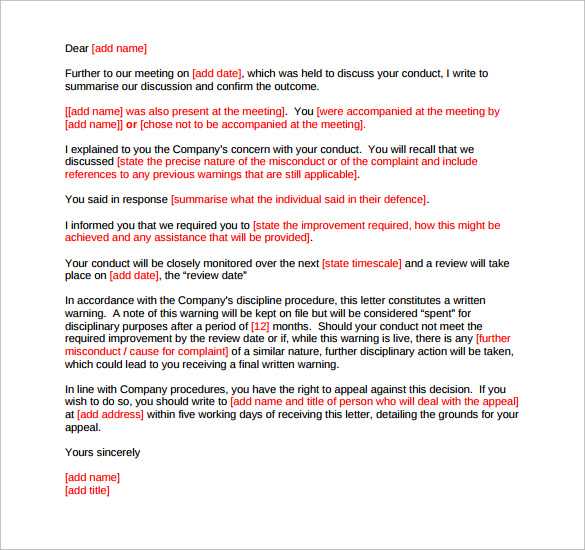
When managing a team, addressing performance or behavioral issues is inevitable. In these moments, it is essential to maintain clear, direct, and professional communication. The way you express concerns and expectations can significantly impact both the individual and the overall work environment.
There are instances when a serious message must be delivered to an employee, signaling the final step before more severe actions are taken. This type of communication should be precise and considerate to ensure the message is understood and to avoid potential legal complications.
Having a well-structured document to formalize such interactions ensures consistency and clarity. A strong, professional format helps outline the situation, expectations for improvement, and potential consequences, offering both the employee and employer a clear understanding of what is at stake.
Why You Need a Final Warning Letter
In a professional setting, clear communication is vital when addressing behavioral or performance issues. In some cases, more than just a casual conversation is required to convey the seriousness of the situation. This formal document plays a critical role in establishing boundaries and ensuring mutual understanding between employer and employee.
Here are the key reasons why this type of communication is necessary:
- Clarity: A formal notice clearly outlines the problem and the expectations for improvement, ensuring both parties understand the gravity of the issue.
- Documentation: Having a written record serves as proof that the issue was addressed and that the employee was given a fair opportunity to rectify their behavior.
- Legal Protection: In case of future disputes or legal actions, this document can protect your company by demonstrating due diligence in handling employee issues.
- Professionalism: It communicates the matter in a professional, structured way, which helps maintain respect and reduces emotional escalation.
- Final Step: This communication often marks the last chance for the employee to adjust their behavior before more serious consequences are enforced.
Ultimately, this formal approach not only helps resolve issues but also promotes a fair and consistent work environment.
Understanding the Importance of Clear Communication
Effective communication is a cornerstone of successful professional relationships. When issues arise, it is essential to address them with clarity to avoid misunderstandings and ensure that the intended message is accurately conveyed. Clear communication fosters transparency, promotes trust, and sets expectations for both parties involved.
Preventing Misinterpretation
One of the key benefits of clear communication is the prevention of misinterpretation. Ambiguous messages can lead to confusion, frustration, and even resentment, which may escalate the situation. By expressing concerns and expectations in a straightforward manner, both the employee and employer are on the same page, reducing the chances of any further complications.
Setting Boundaries and Expectations
When addressing a serious matter, it is crucial to outline clear boundaries and expectations. A well-articulated statement ensures the employee understands what actions need to be taken for improvement, as well as the consequences of failing to do so. This clarity helps avoid future disputes and establishes a framework for accountability.
Key Elements of a Final Warning Letter
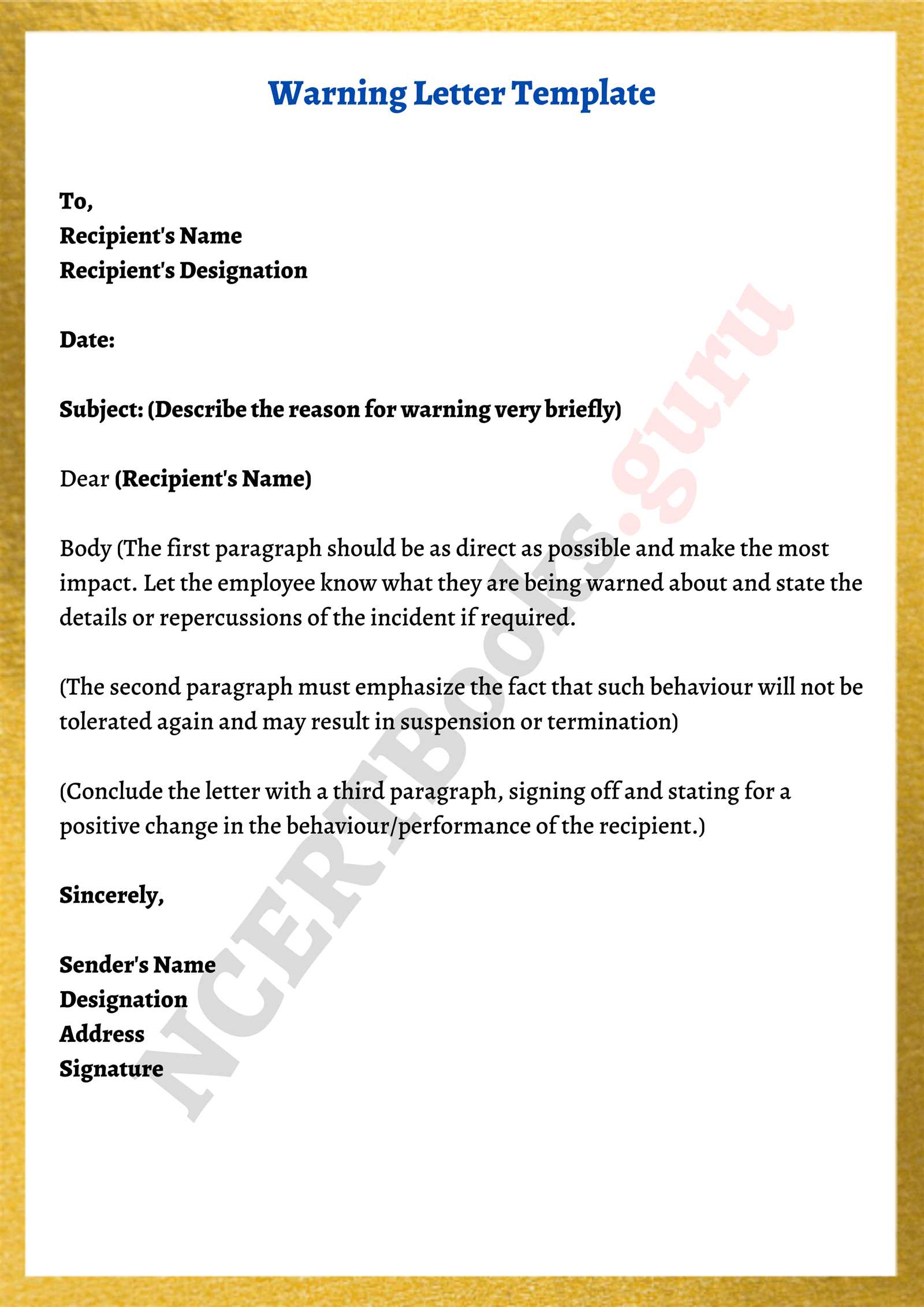
When addressing serious issues with an employee, it is essential to structure your communication in a clear and effective way. A well-crafted document not only ensures that the message is understood but also protects both parties in case of future disputes. There are specific components that must be included to achieve these objectives.
Some of the key elements to include are:
- Employee Information: Include the name, position, and department of the employee involved. This ensures the document is properly addressed and avoids any confusion regarding the individual in question.
- Specific Issue: Clearly outline the behavior or performance issue that led to the formal communication. Be as specific as possible, referencing dates, incidents, and relevant details to avoid ambiguity.
- Previous Discussions: Mention any prior discussions or warnings regarding the issue. This helps establish a clear timeline and demonstrates that the matter has been addressed multiple times before.
- Expected Changes: Clearly state what changes need to be made moving forward. Outline specific actions the employee must take to correct their behavior or performance.
- Consequences: Explain the potential consequences if the employee fails to make the necessary improvements. This sets the tone for the seriousness of the situation and encourages the employee to take corrective action.
- Signature and Date: Ensure the document is signed and dated by the relevant parties to make it official and legally binding.
By including these essential components, the communication becomes more structured, professional, and clear, providing both the employer and employee with a solid understanding of the expectations and potential outcomes.
What to Include for Effectiveness
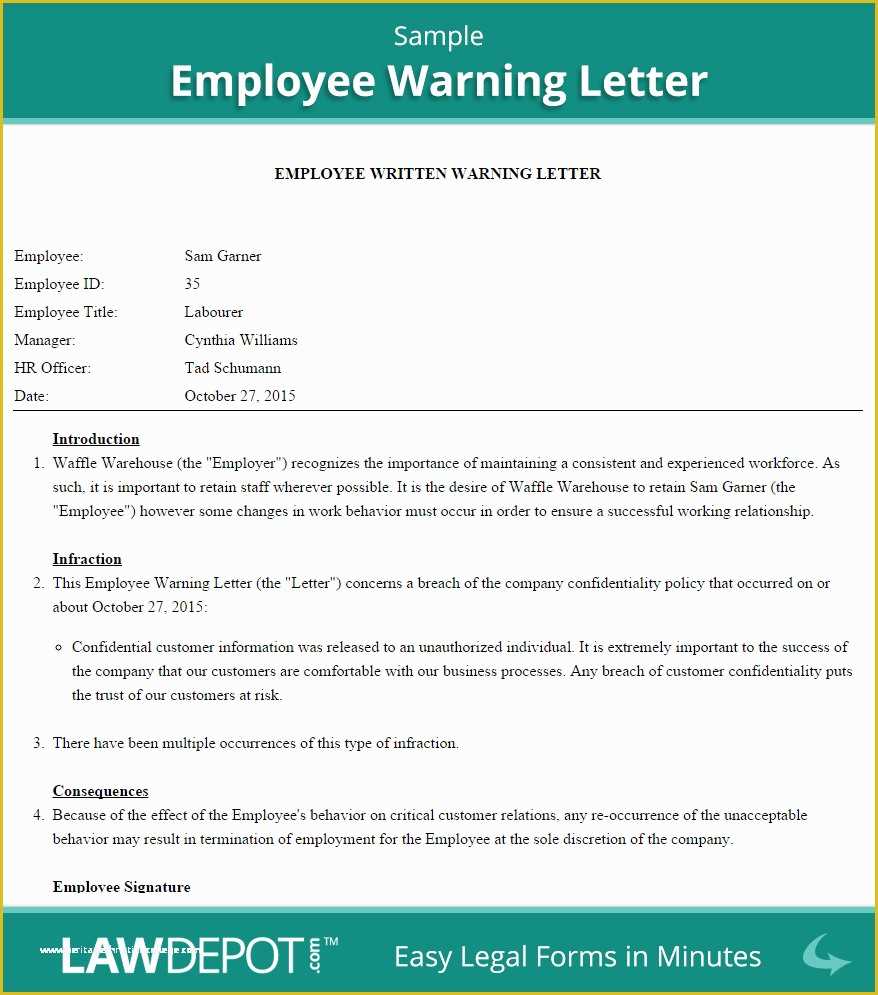
For any formal communication addressing performance or behavioral concerns, it’s essential to include the right components to ensure the message is both clear and impactful. When drafting this type of communication, a well-structured approach makes a significant difference in conveying seriousness while maintaining professionalism. Each element plays a crucial role in ensuring the effectiveness of the message.
Key Components for Clarity and Impact
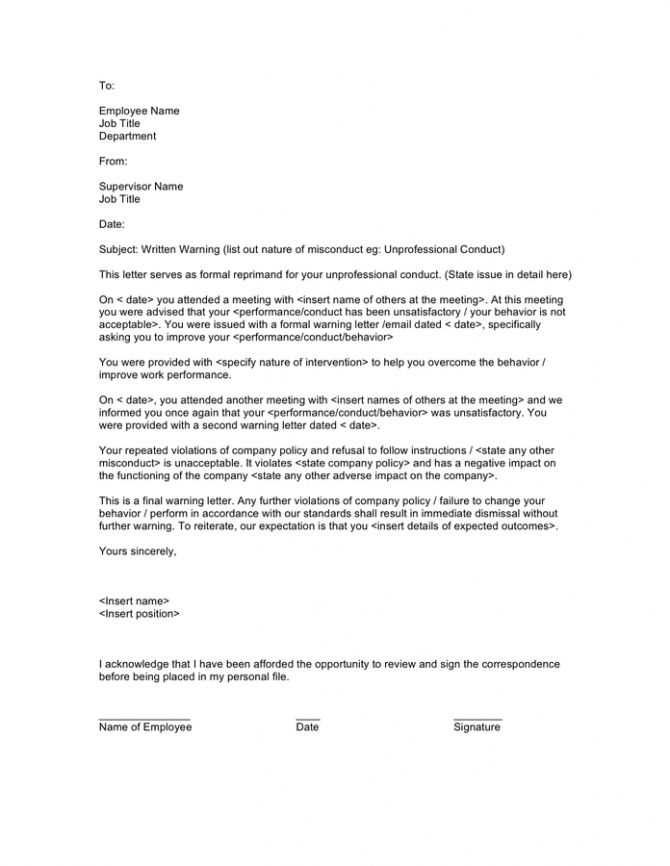
To ensure the communication serves its purpose, include these critical elements:
- Clear Subject Matter: Identify the specific issue in simple, direct terms. Avoid jargon or vague descriptions to prevent misunderstandings.
- Concise Timeline: Outline a clear timeline for expected changes. Provide specific dates for follow-up meetings or actions that must be taken.
- Direct Consequences: Explain what actions will be taken if there is no improvement. Clearly state the potential impact on the employee’s role or employment status.
- Neutral Tone: Use a professional tone throughout, focusing on facts and avoiding emotional language. This helps maintain the professionalism of the situation.
- Support Options: Offer resources or suggestions for improvement, such as training or additional support. This demonstrates a willingness to help the employee succeed.
Additional Considerations for Legal and Ethical Standards
Beyond clarity, ensure that the communication adheres to legal and ethical standards:
- Non-Discriminatory Language: Avoid any language that could be interpreted as discriminatory or biased in nature. Ensure fairness and equality in how the message is conveyed.
- Documented Evidence: If applicable, include supporting documentation or references to prior discussions. This reinforces that the communication is based on factual incidents rather than personal judgment.
By including these key elements, you create a structured and effective communication that encourages positive change while protecting both the individual and the organization.
How to Structure the Letter Professionally
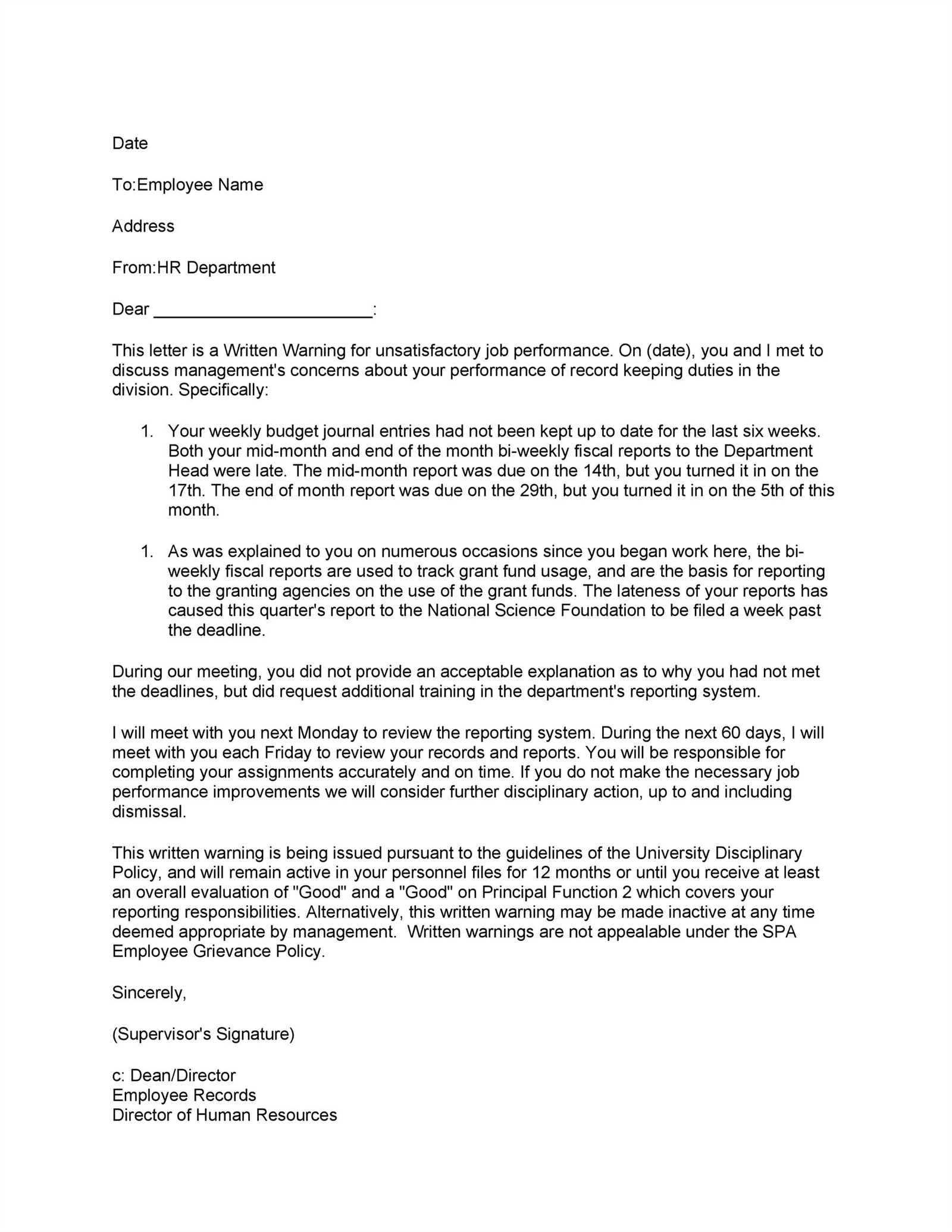
When communicating serious issues in a professional setting, it’s crucial to present the information in a clear, respectful, and organized manner. A well-structured document helps convey the message effectively while maintaining a sense of professionalism and ensuring that all necessary details are covered. A professional approach is essential in fostering constructive dialogue and addressing concerns without escalating tensions.
Organizing the Content for Clarity
To achieve a structured and coherent document, consider the following steps:
- Introduction: Start by clearly stating the purpose of the document. Mention the employee’s name, position, and the context of the communication.
- Specific Issue: Outline the problem at hand. Be concise and specific, including dates and instances where the issue occurred. Avoid generalizations.
- Previous Actions: Reference any prior discussions or corrective actions that have been taken. This helps set the stage for why this formal communication is necessary.
- Expected Changes: Clearly outline what changes or improvements are required. Be specific and measurable to avoid confusion.
- Consequences: Indicate the possible outcomes if no improvement is made. Use professional and neutral language to avoid sounding threatening or punitive.
- Closing: End the document by offering support and expressing hope for a positive outcome. Include your contact information for follow-up.
Maintaining a Professional Tone
While it is essential to be clear and direct, the tone should always remain professional and respectful. Here are some tips for maintaining an appropriate tone:
- Avoid Emotional Language: Stick to the facts and avoid using emotionally charged language that may seem accusatory or condescending.
- Be Neutral: Present the facts in a neutral manner, focusing on the behavior or performance issue rather than personal attributes.
- Offer Support: Frame the message as an opportunity for improvement, and offer any assistance or resources available to help the employee succeed.
By structuring the communication professionally, you not only ensure that the message is received clearly but also create a respectful environment that encourages growth and resolution.
Best Practices for Formatting and Tone
Effective communication requires more than just clear content–it also depends on how the message is presented. Proper formatting and maintaining the right tone are critical to ensuring that the document is both professional and impactful. How you structure the document and the language you use can significantly influence the recipient’s understanding and response.
Formatting for Clarity and Readability
A well-formatted document is easy to read and ensures that the key points stand out. Here are some formatting tips to follow:
- Use Simple Layouts: Keep the layout clean and organized. Use headings, bullet points, and short paragraphs to break up text and make it easier to follow.
- Bold Key Information: Highlight important dates, deadlines, and required actions by bolding or underlining them. This helps the reader quickly identify critical points.
- Consistent Font and Spacing: Use a professional font and maintain consistent spacing throughout the document. This makes it visually appealing and easier to read.
- Clear Contact Information: Ensure that the recipient knows how to reach out for clarification or further discussion. Include relevant contact details at the end of the document.
Maintaining a Respectful and Professional Tone
While the content needs to be clear and direct, the tone plays a significant role in how the message is perceived. Here are some best practices to maintain an appropriate tone:
- Be Direct but Respectful: Avoid beating around the bush. State the issue clearly while being respectful of the recipient’s dignity and professionalism.
- Use Neutral Language: Refrain from using emotionally charged or accusatory words. Focus on the facts and use language that fosters understanding and collaboration.
- Encourage Improvement: While outlining the problem, emphasize the opportunity for growth. Offer constructive suggestions for how the situation can be improved moving forward.
- Avoid Overly Formal Language: While maintaining professionalism, avoid sounding overly stiff or impersonal. Strive for a tone that is both formal and approachable.
By adhering to these formatting and tone guidelines, you can ensure that the communication is effective, respectful, and clear, fostering a positive and constructive outcome.
Common Mistakes to Avoid in Warning Letters
When addressing serious concerns with an employee, the way the message is communicated is crucial to achieving a positive resolution. However, there are several common mistakes that can undermine the effectiveness of the communication and even cause legal or relational issues. Understanding these pitfalls can help ensure the message is clear, professional, and impactful.
| Mistake | Impact | How to Avoid |
|---|---|---|
| Vague Language | Leads to confusion, misinterpretation, and lack of clarity about expectations. | Be specific about the behavior or performance issue. Provide examples and clear descriptions. |
| Overly Emotional Tone | Can escalate tension and lead to a breakdown in communication. | Maintain a neutral, professional tone focused on the facts, not emotions. |
| Failure to Document Previous Warnings | Leaves room for misunderstanding and potential legal issues regarding fairness. | Reference any prior discussions or actions taken to address the issue. |
| Unclear Expectations | May leave the recipient unsure of what needs to be improved. | Clearly outline what changes or actions are required for improvement. |
| Lack of Consequences | Can result in the employee not taking the situation seriously. | Specify the potential consequences of continued poor performance or behavior. |
| Too Much Formality | Can make the communication seem cold and impersonal. | Use a professional but approachable tone to maintain respect and clarity. |
By avoiding these mistakes, you can ensure that the communication remains effective, clear, and conducive to positive change. A well-crafted document not only addresses the issue but also helps maintain a professional relationship between employer and employee.
Ensuring Clarity and Legal Compliance
When addressing serious issues with an employee, it is crucial to ensure that the communication is both clear and legally sound. The document should be structured in such a way that it leaves no room for ambiguity while also adhering to the legal requirements governing employee relations. This dual focus on clarity and compliance not only strengthens the message but also protects the interests of both the employer and the employee.
To maintain clarity, use straightforward language that avoids jargon or complex terms. Each point should be articulated in a simple and direct manner, outlining specific actions or behaviors that need to change. Additionally, include any relevant dates, evidence, or prior warnings to give context to the situation and establish a timeline of events.
Legal compliance requires attention to specific labor laws, anti-discrimination regulations, and company policies. The document should be free from any language that could be perceived as discriminatory or biased. Always ensure that the communication is fair and that the employee has been given ample opportunity to address the issue before this step. Consulting legal professionals or HR experts can also help ensure that the communication meets all necessary legal standards.
By carefully balancing clarity with legal compliance, you ensure that the message is both effective and protects the company from potential legal complications. This approach also fosters a fair and transparent process that benefits all parties involved.